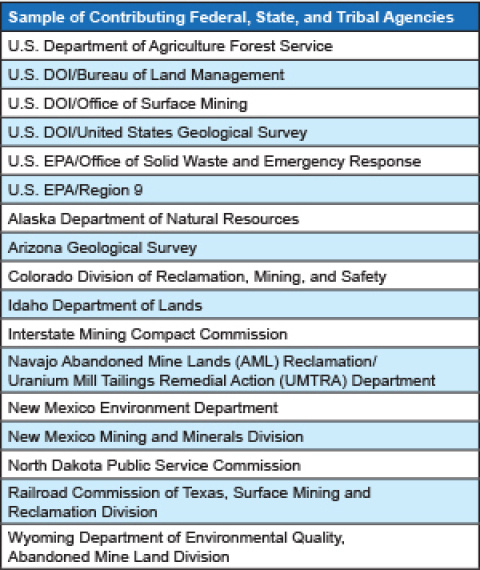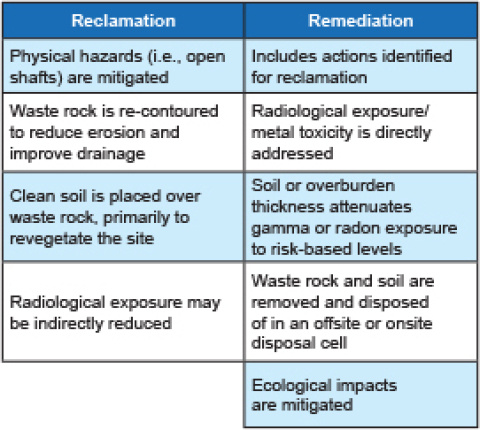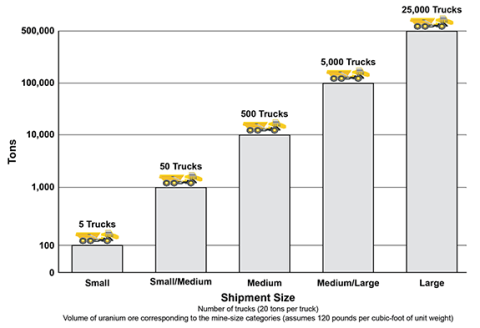The U.S. Department of Energy (DOE) Office of Legacy Management (LM) has made substantial progress researching and consulting with the U.S. Environmental Protection Agency (EPA), the U.S. Department of the Interior (DOI), other relevant federal agencies, affected states and tribes, and the interested public to obtain data and other technical information that will inform the Report to Congress on defense-related legacy uranium mines. Congress directed DOE to undertake a review of, and prepare a report on, abandoned uranium mines (AUMs) in the United States that provided uranium ore for U.S. atomic energy defense activities. The report is due to Congress in July 2014.
| AUM found in the Uravan Mineral Belt, Colorado. |
Articles regarding the Report to Congress appeared in previous program updates. Since the last publication, DOE drafted four technical, topic-specific reports that will provide in-depth data evaluation, inform the Report to Congress, and cover the following subjects:
1. Location and Status – general location of defense-related uranium mines and status of efforts to reclaim and remediate these mines.
2. Cost and Feasibility – potential cost and feasibility of mine reclamation or remediation according to existing law.
3. Assessment of Radiological Risk to Human Health and the Environment – extent to which mines have posed or may pose a radiation health hazard to the public, and degradation to water quality and the environment.
4. Prioritization Report – a priority ranking for reclamation or remediation at the mines.
LM Outreach to Federal, State, and Tribal Agencies
To assist in the development of the four topic-specific reports, DOE exchanged information with a number of federal, state, and tribal agencies, as well as the interested public. DOE was able to obtain an extensive amount of mine-related data. Contributions by technical staff, program managers, and many others from the various entities have proved invaluable. The table on the right identifies a few of the entities that have assisted LM so far. (This is not a comprehensive list. DOE credits many other agencies for their contributions.)
DOE learned from the exchanges that among the agencies and interested public, there is variability in definitions, level of detail, and completeness of data associated with AUMs. For example, LM found there are differences in what are considered to be AUMs as well as reclamation and remediation activities. DOE will address some of these differences in the topic reports.
Abandoned Uranium Mine – Definition
For the DOE AUM Report to Congress, AUM will be identified as a mine that provided uranium ore to the United States for the purpose of defense-related activities. This may include a named mine or complex developed to extract uranium ore sometime between 1947 and 1970 as verified by purchases of the ore by the U.S. Atomic Energy Commission (predecessor agency to DOE) or other means. An applicable mine may be a single feature such as a surface or underground excavation, or it may include an area containing a complex of multiple excavations. It may also include associated mining-related features such as adits and portals, vents, waste rock piles, structures, highwalls, and surface pits.
Reclamation and Remediation
In the Report to Congress, DOE will identify AUM reclamation and remediation as presented in the table on the left.
Data Evaluation
DOE has determined that just over 4,200 AUMs produced approximately 75-million tons of uranium ore for defense-related purposes. The majority of the mines—about 45 percent—produced less than 100 tons of ore. On the other end of the scale, DOE estimates that 37 mines produced more than 500-thousand tons of ore each. The topic-specific reports will describe five sizes of AUMs as measured based on the amount of ore each mine produced (see figure below).
Other analyses have shown that approximately 10 percent of all AUMs are reclaimed or remediated while the majority of mines, about 80 percent, have not been addressed or the status is unknown. The remaining mines are in the process of being reclaimed or remediated, are partially reclaimed or remediated, or are closed or permitted.
For more information about the AUM Report to Congress, please visit DOE’s website at www.lm.doe.gov/AUM. To submit questions, comments, or information about AUM activities, e-mail AUM@lm.doe.gov. All input is welcome and appreciated.





